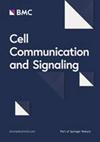高侵袭性黑色素瘤亚群的胞外小泡通过 mir-1246 介导的 CCNG2 抑制作用提高了低侵袭性黑色素瘤细胞的侵袭能力
IF 8.2
2区 生物学
Q1 CELL BIOLOGY
引用次数: 0
摘要
侵袭性生长是肿瘤发展的一个关键过程,需要在侵袭前沿激活肿瘤细胞的各种分子过程。异质肿瘤细胞之间的细胞间通信增强了细胞活化和对特定微环境的适应。细胞间通信的一种机制是通过肿瘤细胞衍生的细胞外囊泡 (EV) 传递 miRNA。在这种情况下,我们观察到来自高侵袭性细胞亚群(BLM-HI)的条件培养基增强了亲本细胞系(BLM)的侵袭能力。因此,我们假设细胞行为的这种复杂变化是受 EV 运送的 miRNA 影响的。用来自 BLM-HI 细胞的 EV 处理 BLM 细胞,会显著增强其侵袭能力,这在 Matrigel 包埋球形细胞和二维 Boyden 室试验中均可观察到,且具有剂量依赖性。相反,当鞘磷脂酶抑制剂抑制EVs分泌时,BLM细胞的侵袭能力会降低。为了探究这种效应背后的分子机制,我们进行了下一代测序,发现这些EVs中富含miR-1246。在功能分析中,我们证明了由 EV 介导的 miR-1246 的传递和过表达都有助于增强 BLM 细胞的侵袭性。我们在细胞周期蛋白 G2(CCNG2)的 3'UTR 中发现了 miR-1246 的结合位点,并通过荧光素酶报告实验证明了其直接结合。在其他恶性肿瘤中,CCNG2 的表达增加与癌症转移和患者预后不良有关。我们的研究表明,细胞间的交流有助于异质黑色素瘤细胞之间通过EV转运的miRNA传递特性,如增加侵袭能力。本文章由计算机程序翻译,如有差异,请以英文原文为准。
Extracellular vesicles from highly invasive melanoma subpopulations increase the invasive capacity of less invasive melanoma cells through mir-1246-mediated inhibition of CCNG2
Invasive growth is a critical process in tumor progression, requiring the activation of various molecular processes in tumor cells at the invasive front. Intercellular communication between heterogeneous tumor cells enhances cellular activation and adaptation to specific microenvironments. One mechanism of intercellular communication is the delivery of miRNAs through tumor cell-derived extracellular vesicles (EVs). In this context we have observed that conditioned media from a highly invasive cell subpopulation (BLM-HI) enhances the invasive capacity of the parental cell line (BLM). Therefore, we hypothesized that this complex change of cellular behavior is influenced by EV-transported miRNAs. The treatment of BLM cells with EVs derived from BLM-HI cells resulted in a significantly enhanced invasive capacity, as observed in Matrigel-embedded spheroids and in 2D Boyden chamber assays, with a dose-dependent effect. Conversely, the invasive capacity of BLM cells was reduced when secretion of EVs was inhibited by a sphingomyelinase inhibitor. To investigate the molecular mechanisms behind this effect, we performed next-generation sequencing and identified an enrichment of miR-1246 in these EVs. In functional analyses we demonstrated that both the EV mediated delivery of miR-1246 as well as overexpression contributes to the enhanced invasiveness of BLM cells. We identified a binding site of miR-1246 in the 3’UTR of cyclin G2 (CCNG2) and demonstrated direct binding by a luciferase reporter assay. Increased expression of CCNG2 has been associated with cancer metastasis and poor patient outcomes in other malignancies. Our study demonstrates that intercellular communication contributes to the transfer of properties, such as increased invasive capacity, between heterogeneous melanoma cells via EV-transported miRNAs.
求助全文
通过发布文献求助,成功后即可免费获取论文全文。
去求助
来源期刊

Cell Communication and Signaling
CELL BIOLOGY-
CiteScore
11.00
自引率
0.00%
发文量
180
期刊介绍:
Cell Communication and Signaling (CCS) is a peer-reviewed, open-access scientific journal that focuses on cellular signaling pathways in both normal and pathological conditions. It publishes original research, reviews, and commentaries, welcoming studies that utilize molecular, morphological, biochemical, structural, and cell biology approaches. CCS also encourages interdisciplinary work and innovative models, including in silico, in vitro, and in vivo approaches, to facilitate investigations of cell signaling pathways, networks, and behavior.
Starting from January 2019, CCS is proud to announce its affiliation with the International Cell Death Society. The journal now encourages submissions covering all aspects of cell death, including apoptotic and non-apoptotic mechanisms, cell death in model systems, autophagy, clearance of dying cells, and the immunological and pathological consequences of dying cells in the tissue microenvironment.
 求助内容:
求助内容: 应助结果提醒方式:
应助结果提醒方式:


